Business Management HRM: A Detailed Analysis of Samsung and BBC
VerifiedAdded on 2023/04/19
|22
|4100
|207
Report
AI Summary
This report provides a detailed analysis of Human Resource Management (HRM) practices at Samsung and BBC. It begins with an introduction to Samsung, highlighting its significance as a South Korean multinational conglomerate and the importance of effective HRM practices for its performance in international markets. The report then delves into the core functions of HRM, including workforce planning, recruitment and selection, training and development, performance management, reward and compensation, employee relations, and compliance with legal, regulatory, and ethical considerations. Specific recruitment strategies employed by Samsung, such as online recruitment and advertisements, are examined. The report also discusses selection strategies, including interviews and selection tests, while acknowledging their potential drawbacks. The second section focuses on BBC, outlining its background as a leading news agency in the UK and exploring its HRM practices, particularly in training and development, reward management, performance management, and flexible working practices. This comprehensive analysis offers valuable insights into the HRM strategies employed by two prominent organizations, providing a comparative perspective on their approaches to managing their workforce.

Running head: BUSINESS MANAGEMENT – HRM
BUSINESS MANAGEMENT – HRM
Name of the Student
Name of the University
Author Note
BUSINESS MANAGEMENT – HRM
Name of the Student
Name of the University
Author Note
Paraphrase This Document
Need a fresh take? Get an instant paraphrase of this document with our AI Paraphraser

1BUSINESS MANAGEMENT – HRM
Section 1 – Samsung
1. Introduction................................................................................................................2
2. Human Resource Management..................................................................................2
3. Workforce Planning...................................................................................................2
4. Recruitment and Selection.........................................................................................7
5. Recruitment strategies of Samsung...........................................................................8
6. Online recruitment.....................................................................................................8
7. Advertisements..........................................................................................................8
8. Selection strategies of Samsung................................................................................8
9. Interviews..................................................................................................................8
10. Selection tests............................................................................................................8
Section 1 – Samsung
1. Introduction................................................................................................................2
2. Human Resource Management..................................................................................2
3. Workforce Planning...................................................................................................2
4. Recruitment and Selection.........................................................................................7
5. Recruitment strategies of Samsung...........................................................................8
6. Online recruitment.....................................................................................................8
7. Advertisements..........................................................................................................8
8. Selection strategies of Samsung................................................................................8
9. Interviews..................................................................................................................8
10. Selection tests............................................................................................................8
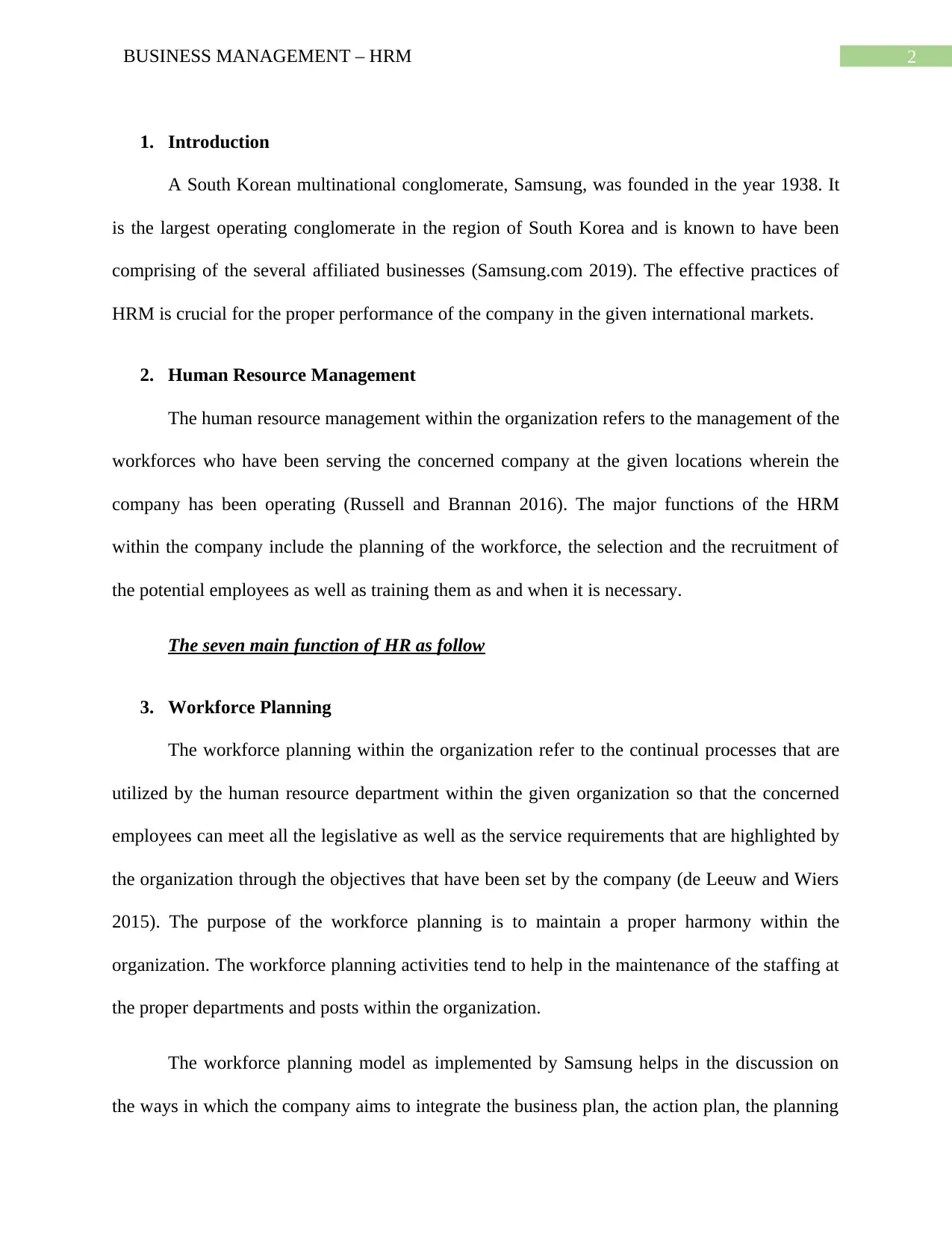
2BUSINESS MANAGEMENT – HRM
1. Introduction
A South Korean multinational conglomerate, Samsung, was founded in the year 1938. It
is the largest operating conglomerate in the region of South Korea and is known to have been
comprising of the several affiliated businesses (Samsung.com 2019). The effective practices of
HRM is crucial for the proper performance of the company in the given international markets.
2. Human Resource Management
The human resource management within the organization refers to the management of the
workforces who have been serving the concerned company at the given locations wherein the
company has been operating (Russell and Brannan 2016). The major functions of the HRM
within the company include the planning of the workforce, the selection and the recruitment of
the potential employees as well as training them as and when it is necessary.
The seven main function of HR as follow
3. Workforce Planning
The workforce planning within the organization refer to the continual processes that are
utilized by the human resource department within the given organization so that the concerned
employees can meet all the legislative as well as the service requirements that are highlighted by
the organization through the objectives that have been set by the company (de Leeuw and Wiers
2015). The purpose of the workforce planning is to maintain a proper harmony within the
organization. The workforce planning activities tend to help in the maintenance of the staffing at
the proper departments and posts within the organization.
The workforce planning model as implemented by Samsung helps in the discussion on
the ways in which the company aims to integrate the business plan, the action plan, the planning
1. Introduction
A South Korean multinational conglomerate, Samsung, was founded in the year 1938. It
is the largest operating conglomerate in the region of South Korea and is known to have been
comprising of the several affiliated businesses (Samsung.com 2019). The effective practices of
HRM is crucial for the proper performance of the company in the given international markets.
2. Human Resource Management
The human resource management within the organization refers to the management of the
workforces who have been serving the concerned company at the given locations wherein the
company has been operating (Russell and Brannan 2016). The major functions of the HRM
within the company include the planning of the workforce, the selection and the recruitment of
the potential employees as well as training them as and when it is necessary.
The seven main function of HR as follow
3. Workforce Planning
The workforce planning within the organization refer to the continual processes that are
utilized by the human resource department within the given organization so that the concerned
employees can meet all the legislative as well as the service requirements that are highlighted by
the organization through the objectives that have been set by the company (de Leeuw and Wiers
2015). The purpose of the workforce planning is to maintain a proper harmony within the
organization. The workforce planning activities tend to help in the maintenance of the staffing at
the proper departments and posts within the organization.
The workforce planning model as implemented by Samsung helps in the discussion on
the ways in which the company aims to integrate the business plan, the action plan, the planning
⊘ This is a preview!⊘
Do you want full access?
Subscribe today to unlock all pages.

Trusted by 1+ million students worldwide
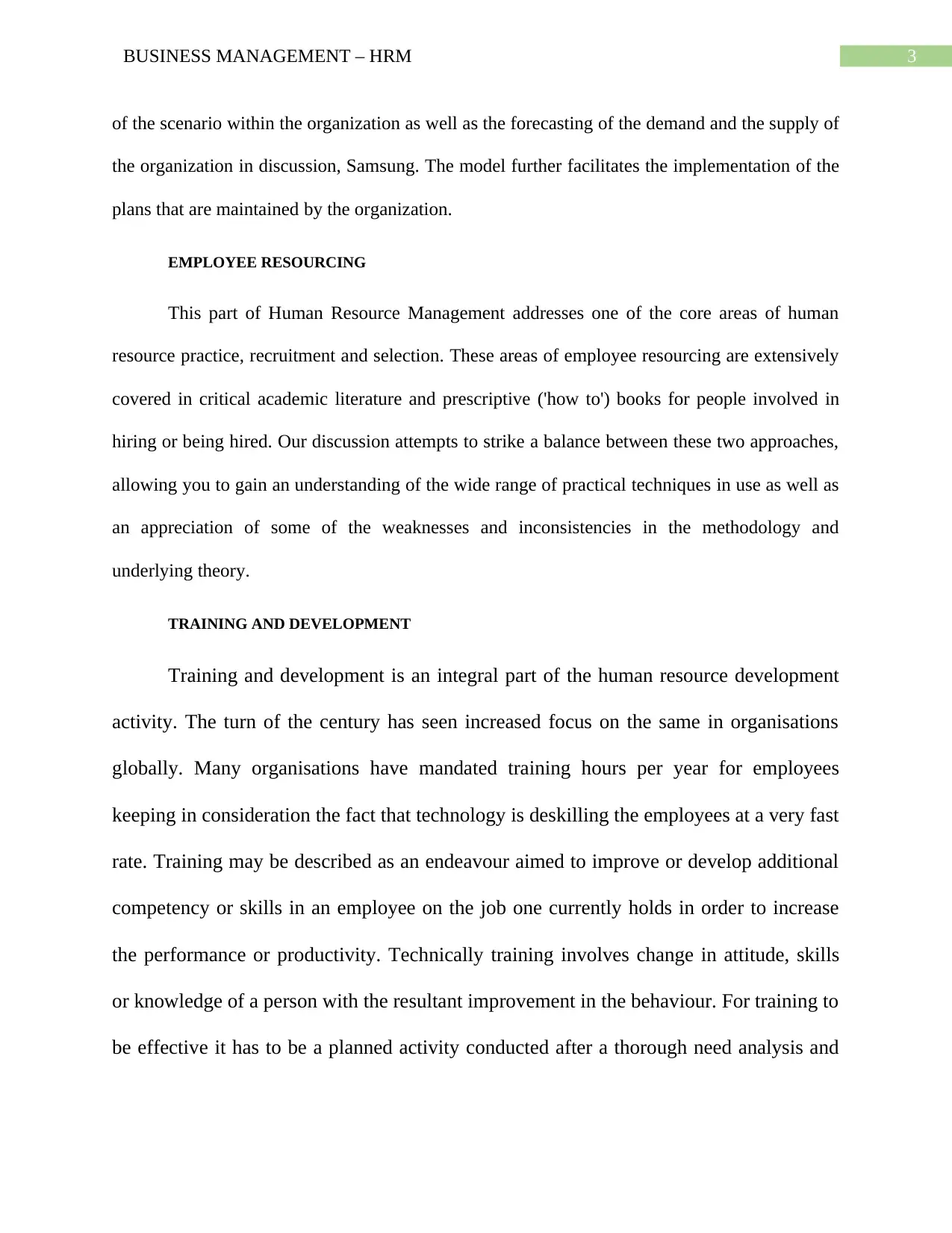
3BUSINESS MANAGEMENT – HRM
of the scenario within the organization as well as the forecasting of the demand and the supply of
the organization in discussion, Samsung. The model further facilitates the implementation of the
plans that are maintained by the organization.
EMPLOYEE RESOURCING
This part of Human Resource Management addresses one of the core areas of human
resource practice, recruitment and selection. These areas of employee resourcing are extensively
covered in critical academic literature and prescriptive ('how to') books for people involved in
hiring or being hired. Our discussion attempts to strike a balance between these two approaches,
allowing you to gain an understanding of the wide range of practical techniques in use as well as
an appreciation of some of the weaknesses and inconsistencies in the methodology and
underlying theory.
TRAINING AND DEVELOPMENT
Training and development is an integral part of the human resource development
activity. The turn of the century has seen increased focus on the same in organisations
globally. Many organisations have mandated training hours per year for employees
keeping in consideration the fact that technology is deskilling the employees at a very fast
rate. Training may be described as an endeavour aimed to improve or develop additional
competency or skills in an employee on the job one currently holds in order to increase
the performance or productivity. Technically training involves change in attitude, skills
or knowledge of a person with the resultant improvement in the behaviour. For training to
be effective it has to be a planned activity conducted after a thorough need analysis and
of the scenario within the organization as well as the forecasting of the demand and the supply of
the organization in discussion, Samsung. The model further facilitates the implementation of the
plans that are maintained by the organization.
EMPLOYEE RESOURCING
This part of Human Resource Management addresses one of the core areas of human
resource practice, recruitment and selection. These areas of employee resourcing are extensively
covered in critical academic literature and prescriptive ('how to') books for people involved in
hiring or being hired. Our discussion attempts to strike a balance between these two approaches,
allowing you to gain an understanding of the wide range of practical techniques in use as well as
an appreciation of some of the weaknesses and inconsistencies in the methodology and
underlying theory.
TRAINING AND DEVELOPMENT
Training and development is an integral part of the human resource development
activity. The turn of the century has seen increased focus on the same in organisations
globally. Many organisations have mandated training hours per year for employees
keeping in consideration the fact that technology is deskilling the employees at a very fast
rate. Training may be described as an endeavour aimed to improve or develop additional
competency or skills in an employee on the job one currently holds in order to increase
the performance or productivity. Technically training involves change in attitude, skills
or knowledge of a person with the resultant improvement in the behaviour. For training to
be effective it has to be a planned activity conducted after a thorough need analysis and
Paraphrase This Document
Need a fresh take? Get an instant paraphrase of this document with our AI Paraphraser
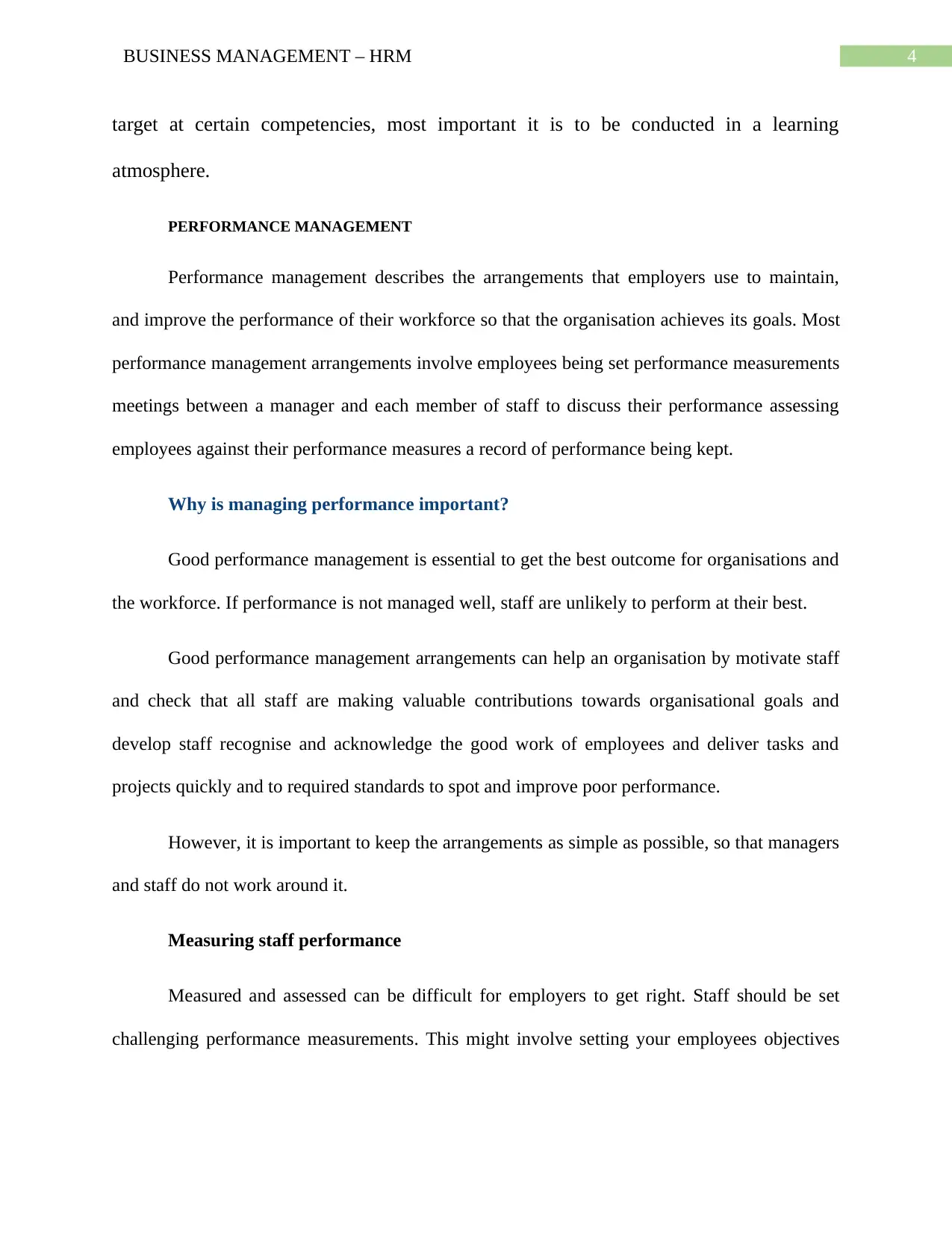
4BUSINESS MANAGEMENT – HRM
target at certain competencies, most important it is to be conducted in a learning
atmosphere.
PERFORMANCE MANAGEMENT
Performance management describes the arrangements that employers use to maintain,
and improve the performance of their workforce so that the organisation achieves its goals. Most
performance management arrangements involve employees being set performance measurements
meetings between a manager and each member of staff to discuss their performance assessing
employees against their performance measures a record of performance being kept.
Why is managing performance important?
Good performance management is essential to get the best outcome for organisations and
the workforce. If performance is not managed well, staff are unlikely to perform at their best.
Good performance management arrangements can help an organisation by motivate staff
and check that all staff are making valuable contributions towards organisational goals and
develop staff recognise and acknowledge the good work of employees and deliver tasks and
projects quickly and to required standards to spot and improve poor performance.
However, it is important to keep the arrangements as simple as possible, so that managers
and staff do not work around it.
Measuring staff performance
Measured and assessed can be difficult for employers to get right. Staff should be set
challenging performance measurements. This might involve setting your employees objectives
target at certain competencies, most important it is to be conducted in a learning
atmosphere.
PERFORMANCE MANAGEMENT
Performance management describes the arrangements that employers use to maintain,
and improve the performance of their workforce so that the organisation achieves its goals. Most
performance management arrangements involve employees being set performance measurements
meetings between a manager and each member of staff to discuss their performance assessing
employees against their performance measures a record of performance being kept.
Why is managing performance important?
Good performance management is essential to get the best outcome for organisations and
the workforce. If performance is not managed well, staff are unlikely to perform at their best.
Good performance management arrangements can help an organisation by motivate staff
and check that all staff are making valuable contributions towards organisational goals and
develop staff recognise and acknowledge the good work of employees and deliver tasks and
projects quickly and to required standards to spot and improve poor performance.
However, it is important to keep the arrangements as simple as possible, so that managers
and staff do not work around it.
Measuring staff performance
Measured and assessed can be difficult for employers to get right. Staff should be set
challenging performance measurements. This might involve setting your employees objectives
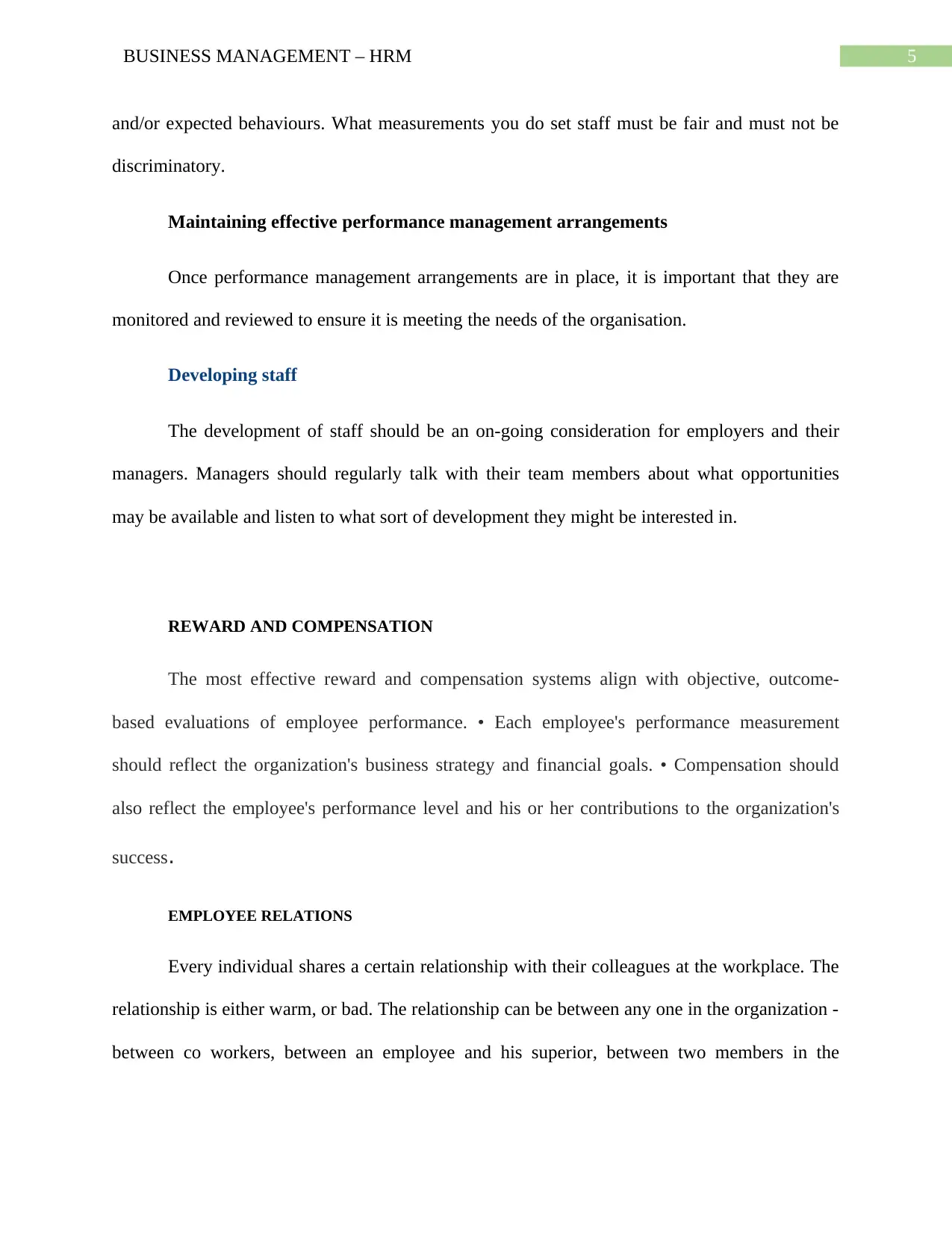
5BUSINESS MANAGEMENT – HRM
and/or expected behaviours. What measurements you do set staff must be fair and must not be
discriminatory.
Maintaining effective performance management arrangements
Once performance management arrangements are in place, it is important that they are
monitored and reviewed to ensure it is meeting the needs of the organisation.
Developing staff
The development of staff should be an on-going consideration for employers and their
managers. Managers should regularly talk with their team members about what opportunities
may be available and listen to what sort of development they might be interested in.
REWARD AND COMPENSATION
The most effective reward and compensation systems align with objective, outcome-
based evaluations of employee performance. • Each employee's performance measurement
should reflect the organization's business strategy and financial goals. • Compensation should
also reflect the employee's performance level and his or her contributions to the organization's
success.
EMPLOYEE RELATIONS
Every individual shares a certain relationship with their colleagues at the workplace. The
relationship is either warm, or bad. The relationship can be between any one in the organization -
between co workers, between an employee and his superior, between two members in the
and/or expected behaviours. What measurements you do set staff must be fair and must not be
discriminatory.
Maintaining effective performance management arrangements
Once performance management arrangements are in place, it is important that they are
monitored and reviewed to ensure it is meeting the needs of the organisation.
Developing staff
The development of staff should be an on-going consideration for employers and their
managers. Managers should regularly talk with their team members about what opportunities
may be available and listen to what sort of development they might be interested in.
REWARD AND COMPENSATION
The most effective reward and compensation systems align with objective, outcome-
based evaluations of employee performance. • Each employee's performance measurement
should reflect the organization's business strategy and financial goals. • Compensation should
also reflect the employee's performance level and his or her contributions to the organization's
success.
EMPLOYEE RELATIONS
Every individual shares a certain relationship with their colleagues at the workplace. The
relationship is either warm, or bad. The relationship can be between any one in the organization -
between co workers, between an employee and his superior, between two members in the
⊘ This is a preview!⊘
Do you want full access?
Subscribe today to unlock all pages.

Trusted by 1+ million students worldwide

6BUSINESS MANAGEMENT – HRM
management and so on. It is important that the employees share a healthy relationship with each
other to deliver their best performances.
An individual spends his or her maximum time at the workplace and his fellow workers
are the ones with whom he spends the maximum hours in a day. No way can he afford to fight
with their colleagues. Conflicts and misunderstandings only add to tensions and in turn decrease
the productivity of the individual. One needs to discuss so many things at work and needs the
advice and suggestions of all to reach to a solution which would benefit the individual as well as
the organization. No individual can work alone. He or she needs the support and guidance of his
fellow workers to come out with a brilliant idea and deliver his level best.
Compliance to Legal, Regulatory and Ethical Considerations
The company in discussion is required to look into the development of the organizational
employees in terms of the legal, regulatory and ethical considerations that are to be maintained in
order to facilitate the proper functionality within the organization. The company in discussion is
advised to maintain the legal factors that are presented within the territorial boundaries of the
country. The company is advised to abide by the Equal Pay Act 1970. This would ensure the
equality in the payment towards the employees of the organization on the basis of their skills.
The company should also prtomote the well-being of the employees as well as take special notice
on their maintenance of the health issues. The company might be advised to implement the
health regulations within the organizational workforce. The company might further be advised to
deal with the maintenance of diversity within the organization through the implementation of the
Equality Act 2010. The implementation of the Equality Act 2010 helps in the inclusion of the
diverse staff within the company. The Equality Act 2010 further helps in the implementation of
management and so on. It is important that the employees share a healthy relationship with each
other to deliver their best performances.
An individual spends his or her maximum time at the workplace and his fellow workers
are the ones with whom he spends the maximum hours in a day. No way can he afford to fight
with their colleagues. Conflicts and misunderstandings only add to tensions and in turn decrease
the productivity of the individual. One needs to discuss so many things at work and needs the
advice and suggestions of all to reach to a solution which would benefit the individual as well as
the organization. No individual can work alone. He or she needs the support and guidance of his
fellow workers to come out with a brilliant idea and deliver his level best.
Compliance to Legal, Regulatory and Ethical Considerations
The company in discussion is required to look into the development of the organizational
employees in terms of the legal, regulatory and ethical considerations that are to be maintained in
order to facilitate the proper functionality within the organization. The company in discussion is
advised to maintain the legal factors that are presented within the territorial boundaries of the
country. The company is advised to abide by the Equal Pay Act 1970. This would ensure the
equality in the payment towards the employees of the organization on the basis of their skills.
The company should also prtomote the well-being of the employees as well as take special notice
on their maintenance of the health issues. The company might be advised to implement the
health regulations within the organizational workforce. The company might further be advised to
deal with the maintenance of diversity within the organization through the implementation of the
Equality Act 2010. The implementation of the Equality Act 2010 helps in the inclusion of the
diverse staff within the company. The Equality Act 2010 further helps in the implementation of
Paraphrase This Document
Need a fresh take? Get an instant paraphrase of this document with our AI Paraphraser
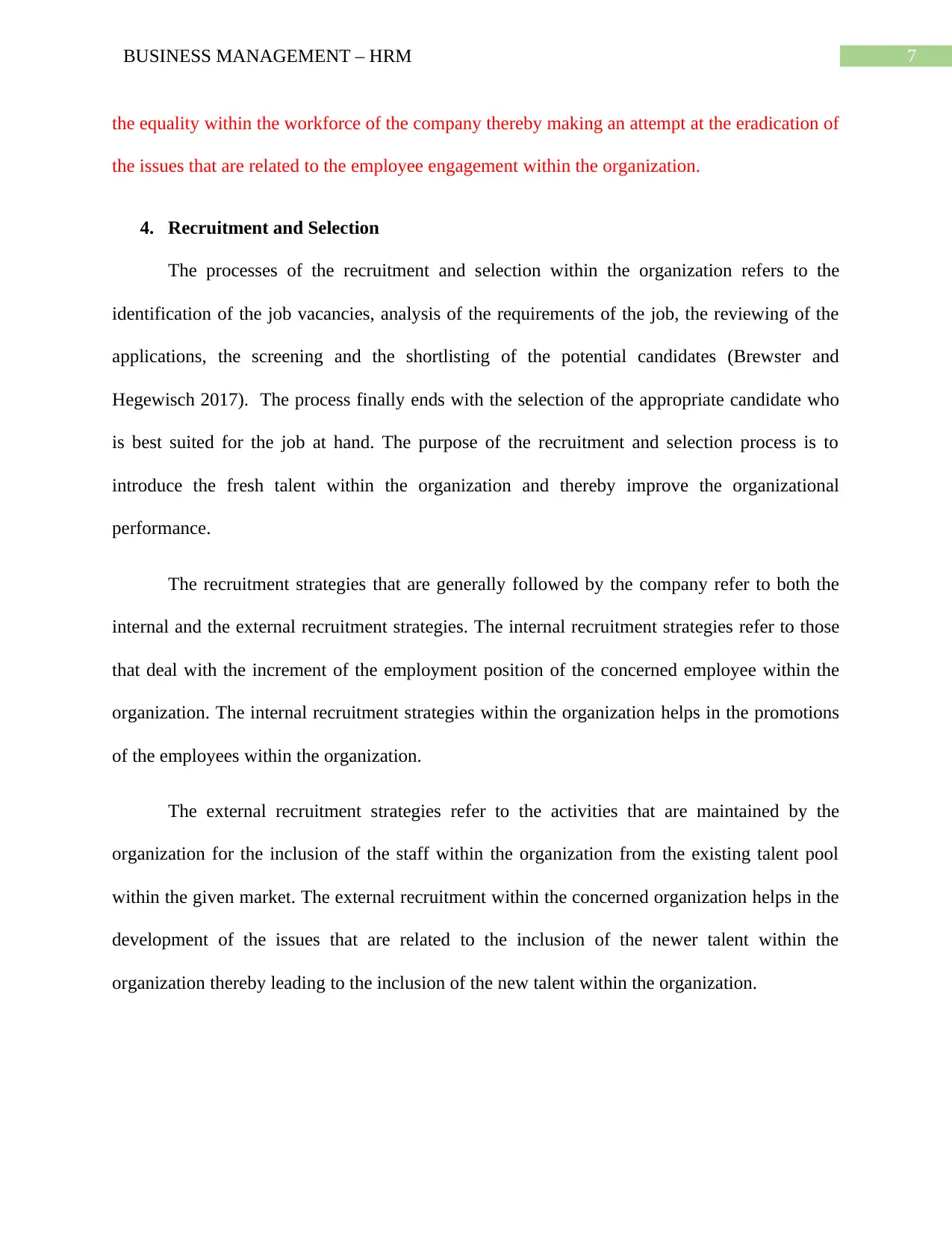
7BUSINESS MANAGEMENT – HRM
the equality within the workforce of the company thereby making an attempt at the eradication of
the issues that are related to the employee engagement within the organization.
4. Recruitment and Selection
The processes of the recruitment and selection within the organization refers to the
identification of the job vacancies, analysis of the requirements of the job, the reviewing of the
applications, the screening and the shortlisting of the potential candidates (Brewster and
Hegewisch 2017). The process finally ends with the selection of the appropriate candidate who
is best suited for the job at hand. The purpose of the recruitment and selection process is to
introduce the fresh talent within the organization and thereby improve the organizational
performance.
The recruitment strategies that are generally followed by the company refer to both the
internal and the external recruitment strategies. The internal recruitment strategies refer to those
that deal with the increment of the employment position of the concerned employee within the
organization. The internal recruitment strategies within the organization helps in the promotions
of the employees within the organization.
The external recruitment strategies refer to the activities that are maintained by the
organization for the inclusion of the staff within the organization from the existing talent pool
within the given market. The external recruitment within the concerned organization helps in the
development of the issues that are related to the inclusion of the newer talent within the
organization thereby leading to the inclusion of the new talent within the organization.
the equality within the workforce of the company thereby making an attempt at the eradication of
the issues that are related to the employee engagement within the organization.
4. Recruitment and Selection
The processes of the recruitment and selection within the organization refers to the
identification of the job vacancies, analysis of the requirements of the job, the reviewing of the
applications, the screening and the shortlisting of the potential candidates (Brewster and
Hegewisch 2017). The process finally ends with the selection of the appropriate candidate who
is best suited for the job at hand. The purpose of the recruitment and selection process is to
introduce the fresh talent within the organization and thereby improve the organizational
performance.
The recruitment strategies that are generally followed by the company refer to both the
internal and the external recruitment strategies. The internal recruitment strategies refer to those
that deal with the increment of the employment position of the concerned employee within the
organization. The internal recruitment strategies within the organization helps in the promotions
of the employees within the organization.
The external recruitment strategies refer to the activities that are maintained by the
organization for the inclusion of the staff within the organization from the existing talent pool
within the given market. The external recruitment within the concerned organization helps in the
development of the issues that are related to the inclusion of the newer talent within the
organization thereby leading to the inclusion of the new talent within the organization.
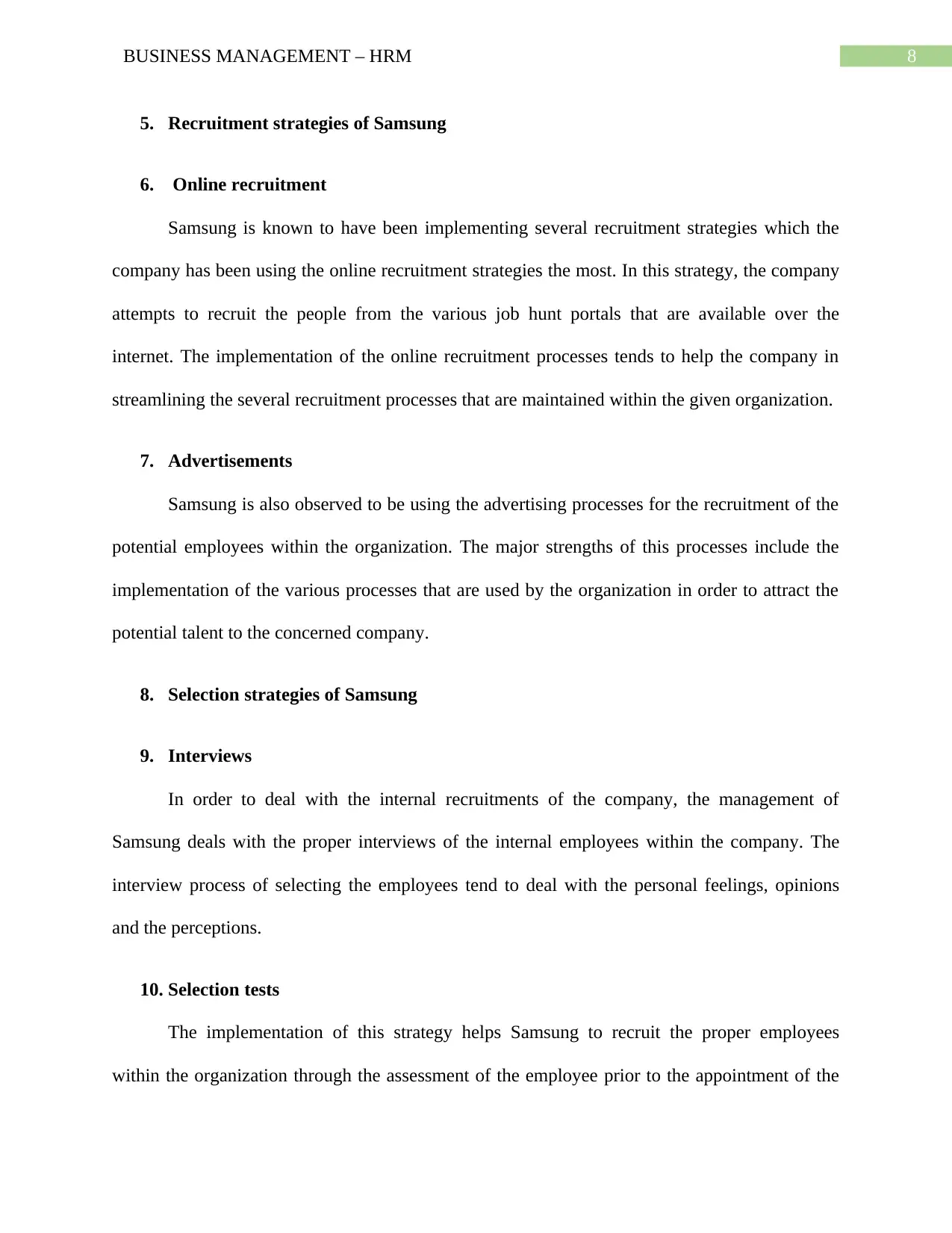
8BUSINESS MANAGEMENT – HRM
5. Recruitment strategies of Samsung
6. Online recruitment
Samsung is known to have been implementing several recruitment strategies which the
company has been using the online recruitment strategies the most. In this strategy, the company
attempts to recruit the people from the various job hunt portals that are available over the
internet. The implementation of the online recruitment processes tends to help the company in
streamlining the several recruitment processes that are maintained within the given organization.
7. Advertisements
Samsung is also observed to be using the advertising processes for the recruitment of the
potential employees within the organization. The major strengths of this processes include the
implementation of the various processes that are used by the organization in order to attract the
potential talent to the concerned company.
8. Selection strategies of Samsung
9. Interviews
In order to deal with the internal recruitments of the company, the management of
Samsung deals with the proper interviews of the internal employees within the company. The
interview process of selecting the employees tend to deal with the personal feelings, opinions
and the perceptions.
10. Selection tests
The implementation of this strategy helps Samsung to recruit the proper employees
within the organization through the assessment of the employee prior to the appointment of the
5. Recruitment strategies of Samsung
6. Online recruitment
Samsung is known to have been implementing several recruitment strategies which the
company has been using the online recruitment strategies the most. In this strategy, the company
attempts to recruit the people from the various job hunt portals that are available over the
internet. The implementation of the online recruitment processes tends to help the company in
streamlining the several recruitment processes that are maintained within the given organization.
7. Advertisements
Samsung is also observed to be using the advertising processes for the recruitment of the
potential employees within the organization. The major strengths of this processes include the
implementation of the various processes that are used by the organization in order to attract the
potential talent to the concerned company.
8. Selection strategies of Samsung
9. Interviews
In order to deal with the internal recruitments of the company, the management of
Samsung deals with the proper interviews of the internal employees within the company. The
interview process of selecting the employees tend to deal with the personal feelings, opinions
and the perceptions.
10. Selection tests
The implementation of this strategy helps Samsung to recruit the proper employees
within the organization through the assessment of the employee prior to the appointment of the
⊘ This is a preview!⊘
Do you want full access?
Subscribe today to unlock all pages.

Trusted by 1+ million students worldwide

9BUSINESS MANAGEMENT – HRM
concerned employee within the organization. The selection processes however tend to have some
drawbacks as well. the major drawbacks lie in the fact that the concerned procedure does not
present the proper and relevant picture of the standing of the candidate. The candidates might
also resort to the honesty at times of responding to the tests.
concerned employee within the organization. The selection processes however tend to have some
drawbacks as well. the major drawbacks lie in the fact that the concerned procedure does not
present the proper and relevant picture of the standing of the candidate. The candidates might
also resort to the honesty at times of responding to the tests.
Paraphrase This Document
Need a fresh take? Get an instant paraphrase of this document with our AI Paraphraser

10BUSINESS MANAGEMENT – HRM
Section 2 – BBC
Introduction........................................................................................................................10
Training and Development................................................................................................10
Reward Management.........................................................................................................10
Performance Management.................................................................................................11
Flexible working practices.................................................................................................11
Section 2 – BBC
Introduction........................................................................................................................10
Training and Development................................................................................................10
Reward Management.........................................................................................................10
Performance Management.................................................................................................11
Flexible working practices.................................................................................................11
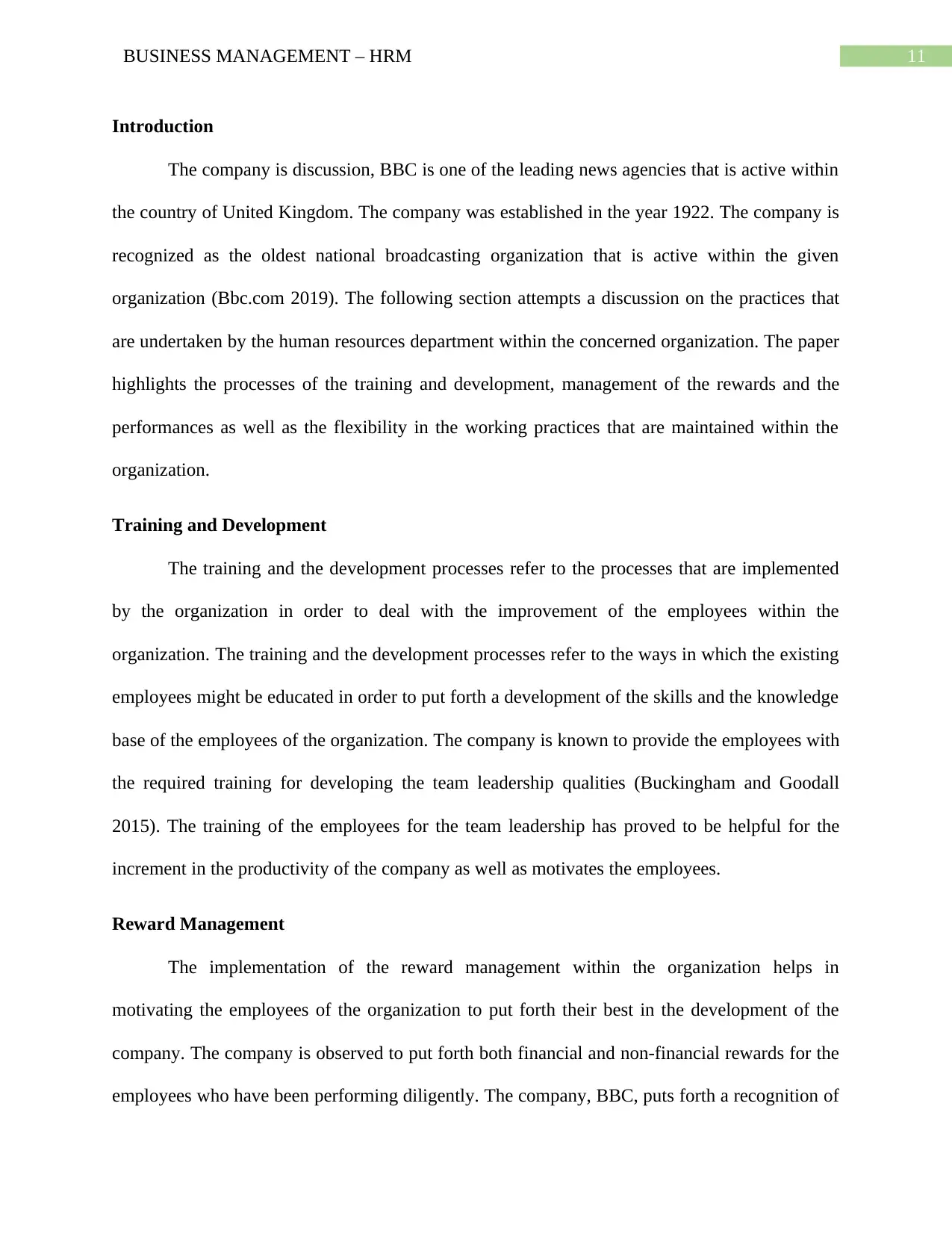
11BUSINESS MANAGEMENT – HRM
Introduction
The company is discussion, BBC is one of the leading news agencies that is active within
the country of United Kingdom. The company was established in the year 1922. The company is
recognized as the oldest national broadcasting organization that is active within the given
organization (Bbc.com 2019). The following section attempts a discussion on the practices that
are undertaken by the human resources department within the concerned organization. The paper
highlights the processes of the training and development, management of the rewards and the
performances as well as the flexibility in the working practices that are maintained within the
organization.
Training and Development
The training and the development processes refer to the processes that are implemented
by the organization in order to deal with the improvement of the employees within the
organization. The training and the development processes refer to the ways in which the existing
employees might be educated in order to put forth a development of the skills and the knowledge
base of the employees of the organization. The company is known to provide the employees with
the required training for developing the team leadership qualities (Buckingham and Goodall
2015). The training of the employees for the team leadership has proved to be helpful for the
increment in the productivity of the company as well as motivates the employees.
Reward Management
The implementation of the reward management within the organization helps in
motivating the employees of the organization to put forth their best in the development of the
company. The company is observed to put forth both financial and non-financial rewards for the
employees who have been performing diligently. The company, BBC, puts forth a recognition of
Introduction
The company is discussion, BBC is one of the leading news agencies that is active within
the country of United Kingdom. The company was established in the year 1922. The company is
recognized as the oldest national broadcasting organization that is active within the given
organization (Bbc.com 2019). The following section attempts a discussion on the practices that
are undertaken by the human resources department within the concerned organization. The paper
highlights the processes of the training and development, management of the rewards and the
performances as well as the flexibility in the working practices that are maintained within the
organization.
Training and Development
The training and the development processes refer to the processes that are implemented
by the organization in order to deal with the improvement of the employees within the
organization. The training and the development processes refer to the ways in which the existing
employees might be educated in order to put forth a development of the skills and the knowledge
base of the employees of the organization. The company is known to provide the employees with
the required training for developing the team leadership qualities (Buckingham and Goodall
2015). The training of the employees for the team leadership has proved to be helpful for the
increment in the productivity of the company as well as motivates the employees.
Reward Management
The implementation of the reward management within the organization helps in
motivating the employees of the organization to put forth their best in the development of the
company. The company is observed to put forth both financial and non-financial rewards for the
employees who have been performing diligently. The company, BBC, puts forth a recognition of
⊘ This is a preview!⊘
Do you want full access?
Subscribe today to unlock all pages.

Trusted by 1+ million students worldwide
1 out of 22
Related Documents
Your All-in-One AI-Powered Toolkit for Academic Success.
+13062052269
info@desklib.com
Available 24*7 on WhatsApp / Email
![[object Object]](/_next/static/media/star-bottom.7253800d.svg)
Unlock your academic potential
Copyright © 2020–2025 A2Z Services. All Rights Reserved. Developed and managed by ZUCOL.




